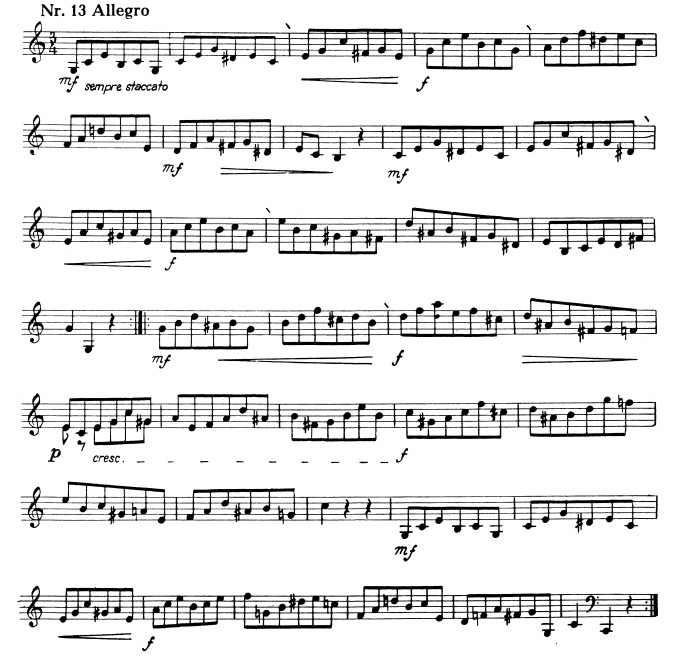Music
As I’ve mentioned in all my other Kopprasch etude walkthroughs, you can either get a free version of the Kopprasch etudes from IMSLP, or you can spring for a slightly nicer and better edited version. Either way, these are etudes that you should get. They cover a lot of the basics of horn playing and they are often used for All-State audition music. Here’s #13:
Key Points
- The name of the game in this etude – arpeggios. To quote a popular meme, if you don’t know your arpeggios – you’re going to have a bad time. I’ve got both one- and two-octave arpeggio and scale sheets over here.
- Once you’ve learned your arpeggios, make sure you are able to identify them when they pop up. Although this music looks complex, it doesn’t actually move through different keys that fast. Learn how to identify arpeggio inversions, and you’ll be surprised at how easy it is to hear some of these progressions ahead of time. For example, the first four bars are just a C major arpeggio!
- There are a lot of “leading” tones in this music – for example, in the first 7 bars the 4th note in each bar (and occasionally the last note in the bar) is not in the arpeggio, but “leads” to an arpeggio note. Notice which notes are “leading” (hint: usually they have an accidental) and make sure to give those notes extra attention.
- The staccato refers to note length, not air flow. Even with separated notes your airflow should be constant throughout this etude.
- The large number of fairly big leaps cause this etude to cover quite a large range quickly. If you need to slightly
shift your embouchure to make these ranges in register, practice making the changes as small as possible.
Technical Tips
- Articulation – If accurately tonguing the notes is a problem, start this etude slower and slurred. Once you’re able to slur accurately, add back in the tonguing. Remember that the air doesn’t stop during tonguing, it is just interrupted. Make sure you are using a “Ta” syllable and keep the fronts of the notes as square as possible. You can read more about that here.
- Arpeggios – Like I said before, if you don’t know them, learn them. They are only three notes per key, after all. Once you can play them in root position (1-3-5-1), start practicing them in different inversions (3-5-1-3, 5-1-3-5). Knowing these (and their corresponding scales) will help you in all your music! Arpeggios are also available on my horn exercises page.
- The “leading” notes – If you’re having trouble finding the leading notes (such as the D# in bar one), practice playing the first bar out of time as G-C-E-C-G, then add in the B, so that it’s G-C-E-C(B)C-G, and then play it as it’s written in the bar – G-C-E-B-C-G. It’s vitally important that all the leading notes are correct, since if they are wrong, the note immediately following will (likely) be incorrect as well. Having the middle C both before and after the B lets you more easily hear how close those two notes actually are – which makes your accuracy that much better.
- Shifting registers – If you find that you need to slightly adjust your embouchure for certain registers – for example, between the low G and the C in bar 1, or the final two notes – that is not uncommon. With the large range and small mouthpiece of the horn, most people have at least 1 or 2 (usually more) shift points. Practice slurring back and for between two notes that are in different “gears”, to find the transition is easiest and fastest to make. This is also very useful to do on the mouthpiece.
- Modifications – One of the nice things about Kopprasch etudes is they take well to small alterations. If this one is too easy as is, try playing it all slurred, or slur-3-tongue-3, you can also transpose it – down a whole step or two is interesting. Down an octave makes it work a completely different register. Also, try it in one beat per bar.


